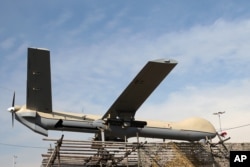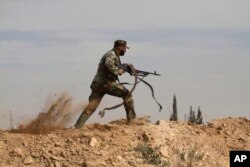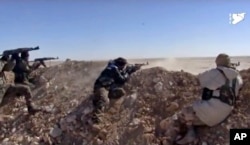Iran’s missile strike this week against Islamic State targets in Syria is escalating its military involvement in Syria and likely will heighten tensions between the U.S.-led coalition and Russian and Iranian forces aligned with the Syrian regime, analysts say.
The strike — the first time Iran fired missiles outside its borders in 30 years — was meant as retaliation for the IS-claimed twin terror attacks in Tehran on June 7 that killed 17 people and wounded more than 50, Iranian officials said.
According to a statement released by the Islamic Revolutionary Guard Corps (IRGC), the missile strikes on Sunday hit IS command centers in the eastern Syrian city of Deir Ezzor and a bomb-manufacturing facility outside the city.
The IRGC statement said that the attack “was a message” and a “warning” to “Takfiri terrorists, their regional supporters and their supporters outside of the region.”
The term takfiri is used by Iranian officials when referring to militant Sunni Muslim fundamentalist groups such as IS.
But Iranian state-run media said the missile strikes carried a greater message to Iran’s perceived enemies — Israel, Saudi Arabia and the U.S.
Kayhan Daily, a conservative newspaper close to Tehran’s leadership, published an editorial saying the strikes were more than “just a response” to the IS attack in Tehran.
“The strikes confirmed Iran’s missile capabilities to shenanigans who dispatched terrorists to Tehran,” the editorial said, adding that Iran’s "slap was a loud message for the supporters of terrorists in Riyadh and Tel-Aviv.”
Old rivalry
Tensions between longtime rivals Saudi Arabia and Iran have escalated in recent weeks after the Saudis and their Gulf partners cut ties to Qatar, citing, in part, its association to Iran and Tehran's alleged link to terrorism.
Iran has stepped up its anti-Saudi rhetoric since the IS-attacks saying Riyadh is trying to destabilize the country by supporting dissidents. Supreme Leader Ayatollah Ali Khamenei said the attacks would only increase hate for the U.S. and Saudi governments, according to state media.
The U.S.-led coalition in Syria meanwhile is keeping a close eye on Iran’s military involvement with the Syrian regime. U.S. officials told VOA they were close to confirming that an Iranian-made drone shot down by an American fighter jet early Tuesday in Syria was being operated by the IRGC.
Iran has been a major military backer of the Syrian regime, first in its war with rebel groups across the country and later against IS. Led by the IRGC, about 10,000 Iranian combat troops are in Syria fighting alongside thousands of fighters from Hezbollah, Lebanon's Tehran-affiliated Shi'ite militia, and assorted Shi'ite militias.
Hostilities between U.S.-led forces and Iranian and Russian forces supporting the Syrian regime have escalated in recent weeks in a part of Syria seen as strategically important for the Syrian government and Iran, as Tehran seeks to secure a land corridor between forces it backs in Syria and Iraq.
“Iran's missile attacks on IS was a great measure preventing the U.S. from opposition,” said Syrian Information Minister Mohammad Ramez Tourjman. "Iran, at different levels, confronts any threat which may target the Islamic Republic, and the country's missile strikes had a message that deterred the U.S. from even thinking of attacking Iran or isolating the country."
The Iranian missile strike was an intended provocation on Tehran’s part, analysts say.
“Tehran’s muscle flexing was aimed at U.S. and Saudi Arabia, in particular in the context of recent developments in the region,” said Kamran Matin, an analyst at the University of Sussex.
“The intensification of the Saudi-led 'containment of Iran' strategy backed by the Trump administration, and the evidence of U.S.’s proactive measures against Syrian armed forces and their allies in Eastern Syria, could be interpreted as the main impetus for Tehran’s missile attack on IS targets in Syria,” he said.
Determined coalition
The U.S.-led coalition said that while it is not trying to escalate conflict with Iran and Russia in Syria, it will not back down.
“The coalition’s mission is to defeat IS in Iraq and Syria,” the coalition said in a statement. “The coalition does not seek to fight the Syrian regime, Russian, or pro-regime forces partnered with them, but will not hesitate to defend coalition or partner forces from any threat.”
But Iranian president Hassan Rouhani said the “Islamic Republic will respond more decisively to any future terrorist attack on Iran's soil.” And former IRGC Guard chief Gen. Mohsen Rezai wrote on Twitter, "The bigger slap is yet to come."
Still, analysts caution that Tehran’s rhetoric may be more for domestic consumption.
“Tehran has long depicted an invincible image of immunity from IS, claiming that its security forces are capable of turning down any threats from IS miles beyond its border,” said Habib Hosseinifard, an Iranian affairs analyst based in Germany. “This missile attack was also aimed to cover that wound as well.”













